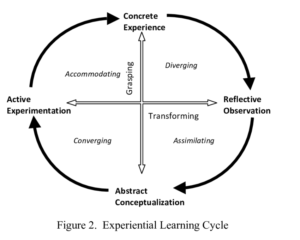Instead of traditional teaching approaches, experiential learning initiates a new idea of teaching. In the past, teachers are the core of the class. Students received information only from teachers. Students will make notes and remember the conclusions. It is not easy to teach and students are hard to understand inner principles. From our learning experiences, if we understand principles, it will help us to remember formulas more easily and quickly. Rote learning is the worst method for students because they remember slowly and forget quickly. Experiential learning is an efficient approach to solving this problem.
Instead of conclusions, experiential learning focus on the learning process. During the process, students are the core of classes. Learners are passive to accept information. Teachers are leaders. They will plan the schedule and create activities to make a balance of courses. They aim to use teaching tools to help learners to do experiments. Experiential learning is using widely in our life. There is a simple example, bungee jumping. Workers are like teachers and tell you the attention and others’ feeling. However, if you do not jump, you will never get the feel and how brave you are. Experiential learning is good at encouraging learners. Teacher gives learners the direction. Learners will follow the direction and explore by themselves. In traditional classes, people have fewer chances to practices knowledge. The advantage of experiential learning is that it provides a space for learners to use promptly so that learners can successfully enter the live language expression and exchange of ideas.
There is a model created by David Kolb. It is a 4-step cyclic process. Kolb realized that the current experience is based on introspective observation. This presents a conceptual analysis and can be tested actively. Such a test produces a new experience, so the cycle begins. This model allows various possibilities of personal preference for learning styles to exist, for example, some people prefer thinking, some people prefer action. This implication is that an effective learner has room to apply a wide range of learning styles.

There is a video showing tips for experiential learning based on Kolb’s model. There are 5 steps. These steps mix all theories and models of experiential learning. Experiential learning is mostly using in business training or organizations. We also can find it everywhere in our life. Sephora is a good example. We can try a new product and share feelings with others. After we buy it, we will think about whether it is really comfortable for you. We can leave comments and we will make a choice better next time if we meet similar products.
- Experience
- Share
- Process
- Generalize
- Apply
Experiential learning is used in our learning resources. In our interactive activities, we set a debate session for our outcome 4. Students will be divided into two factions. One is supporters of the development of AI, and another is non-supporters. Students will look up information and search for other views to support their own ideas. They need to summarize and communicate with their group members. During the period, they will learn how to view a question dialectally. They will not only remember these opinions but think and reflect the different views. Teachers can lead them to form the cogitation but cannot make cogitation and put it in their brains.
Reference:
Experiential learning, Retrieved from https://en.wikipedia.org/wiki/Experiential_learning
Saul McLeod(2017), Kolb’s Learning Styles and Experiential Learning Cycle, Retrieved from https://www.simplypsychology.org/learning-kolb.html
David Kolb, Experiential Learning Cycle, Retrieved from Research Gate https://www.researchgate.net/figure/The-Experiential-Learning-Cycle_fig2_288172293
HumberCTL(Publisher), Teaching Tips Experiential Learning Model, Retrieved from https://www.youtube.com/watch?v=GDchcHORheM